


Iridium - goddess of the rainbow
The element iridium is called after the goddess Iris, which is the goddess of the rainbow from Greek mythology. There is a good reason for this name. There is no element, which has such a rich and colorful aqueous chemistry as the element iridium. It really is startling to see how many colors can be generated from a simple aqueous solution of iridium chloride with a limited number of very common reagents.
This property is very nice, but it also makes precise analysis of the compounds, formed in all these reactions remarkably difficult. Many of the complexes of iridium are ill-defined and their precise composition is not known. Even the chemical, used as a basis for all experiments on this page, and which was obtained from a commercial supplier, is not a nicely defined chemical.
The starting compound, used for all these experiments is so-called "iridium (IV) chloride", "IrCl4". This formula IrCl4 only is an empirical formula and it certainly does not reflect the real nature of this compound. It is sold as IrCl4, but the real structure is much more complex. This compound most likely is an ill-defined mix of chloro-complexes, free iridium ions and even traces of free chlorine. The only thing, which this formula says is that there is a certain ratio of iridium and chlorine in the compound, which is close to 1 : 4. The compound "IrCl4" has the smell of elemental chlorine.
![]()
![]() Required
chemicals:
Required
chemicals:
-
"iridium (IV) chloride"
-
dilute hydrochloric acid
-
sodium sulfite
-
sodium persulfate
-
dilute ammonia
![]() Required
equipment:
Required
equipment:
-
test tubes
- a small burner for heating test tubes
![]() Safety:
Safety:
- Dilute hydrochloric acid and dilute ammonia are irritating.
![]() Disposal:
Disposal:
- All chemicals, except the iridium compounds, are non-toxic for the environment. The amount of iridium, used in these experiments, is so low, that there is no need to collect the metal-waste. All waste can be flushed down the drain with a lot of water.
![]()
Performing the experiments
This experiment is very simple. Just dissolve a single piece of the solid "iridium (IV) chloride" in a few ml of water. Only approximately 1 mm³ is needed of the solid, which is just a few mg. This compound, when dissolved in water, has a very intense color and even a tiny amount gives a really strong color to the solution.
Change of color of solution of "IrCl4" on standing
Below are three pictures of a solution of "IrCl4". The left picture shows a fresh solution, the middle picture shows the solution, a few hours after preparation, the right picture shows the solution, a few days after preparation.
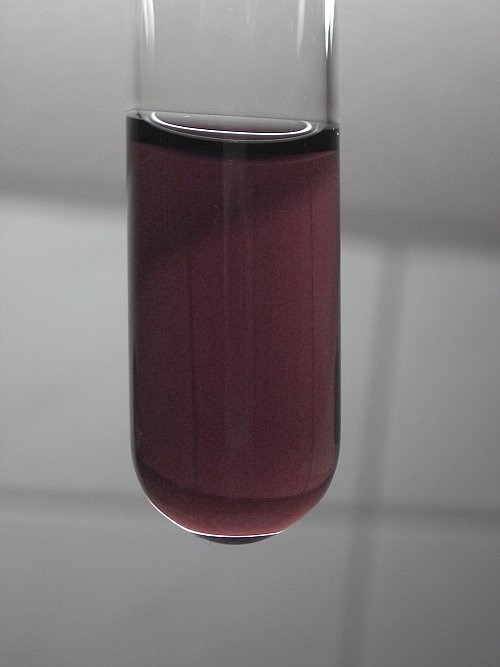
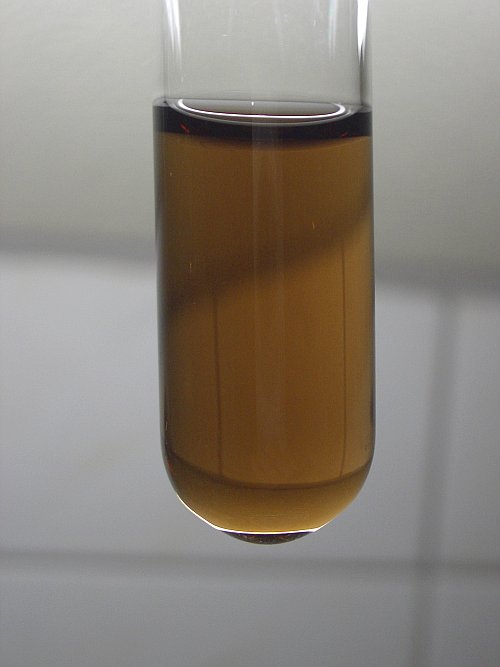
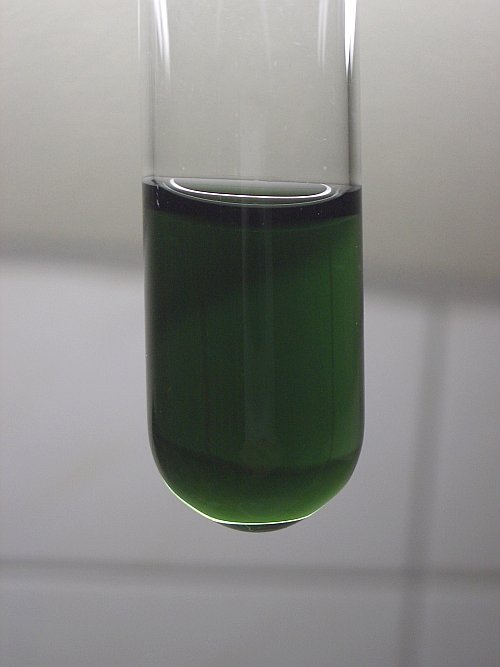
It is remarkable, that the color of the solution changes like this in a few days. These changes most likely are due to ligand-exchange and possibly also due to change of oxidation state of the iridium. This could be possible by means of a slow reaction with water, or by means of splitting off elemental chlorine. The final green color probably is due to the color of the complex ion IrCl63-. According to literature, this ion is olive-green.
Oxidation with persulfate in solution of hydrochloric acid
When the liquid is slightly acidified with dilute hydrochloric acid, and oxidized with sodium persulfate, then a deep red liquid is formed. Below, a picture is shown of the result of oxidation of the green liquid. The same result, however, also is obtained, when the first purplish liquid, or the brown liquid is oxidized in a similar way. The deep red complex IrCl62- ion is formed on oxidation of any chloro-iridium species in aqueous solution. At least, here we have a well-established ion, containing iridium. The ion IrCl62- is well established and well known for over a century now.
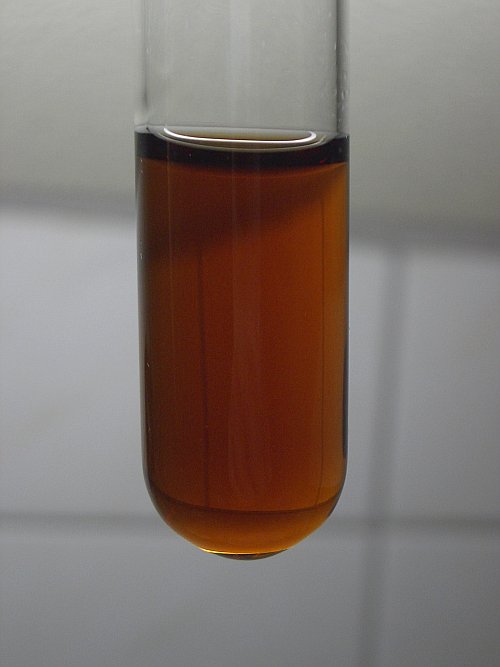
Reduction with sulfite/sulphur dioxide in solution of hydrochloric acid
When a small amount of sodium sulfite is added, such that the liquid remains acidic, then this complex is converted into another complex, which has a pale yellow color. This complex is quite stable and even when all SO2, formed in the reaction between the sulfite and the acid in solution, is driven off by boiling for a short time, the color remains pale yellow. On addition of sodium persulfate, however, this pale yellow complex is destroyed again, and the liquid becomes deep red again, due to formation of IrCl62-.
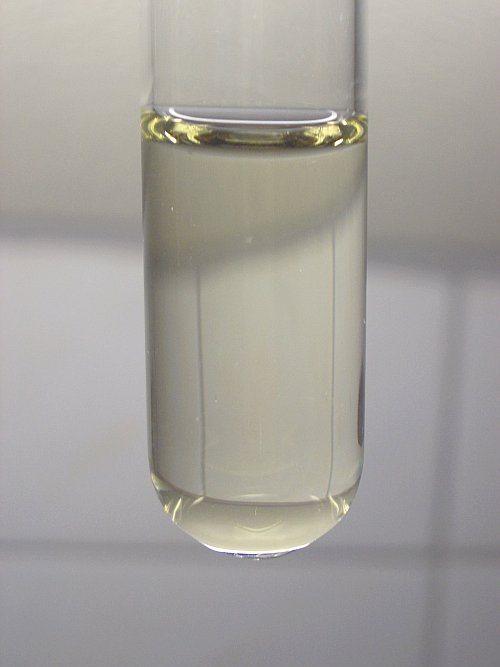
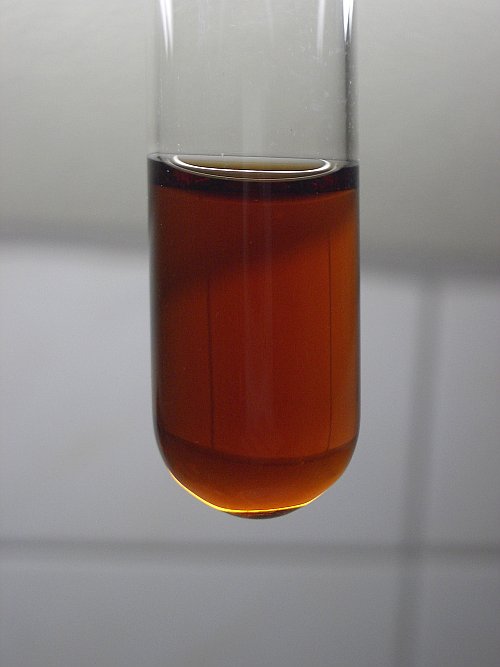
Complex formation with ammonia, and subsequent oxidation
When the green solution of "IrCl4", mentioned above, is mixed with dilute ammonia (5% NH3), then a bluish/green/gray solution is formed. This is shown in the left picture. When some sodium persulfate is added to this bluish/green/gray solution, then the liquid becomes bright purple. On gentle heating, without boiling, the purple liquid becomes beautifully golden yellow. That is shown in the rightmost picture.
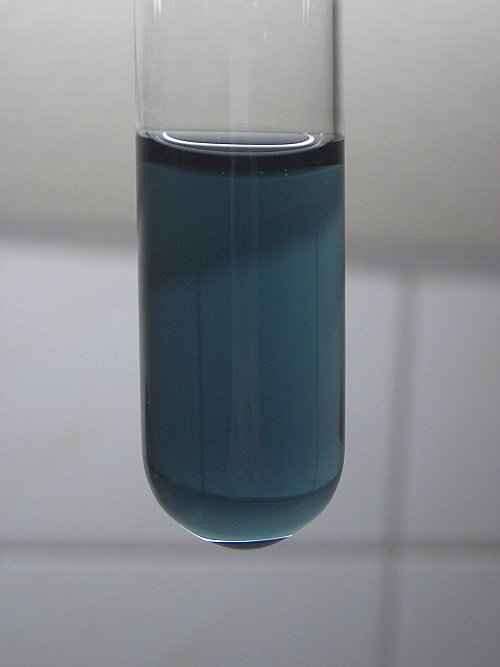
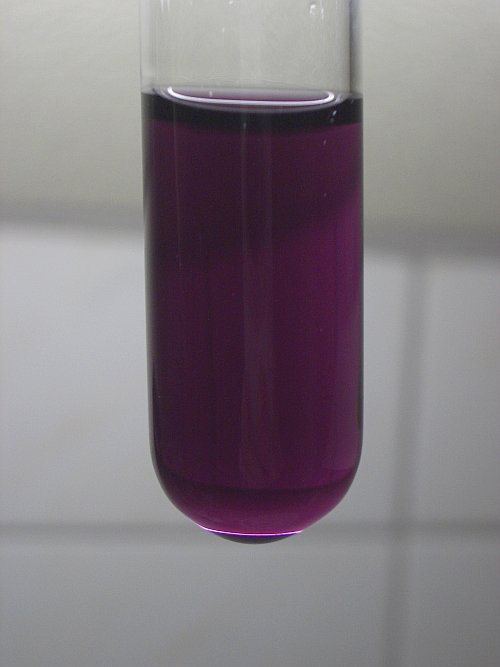
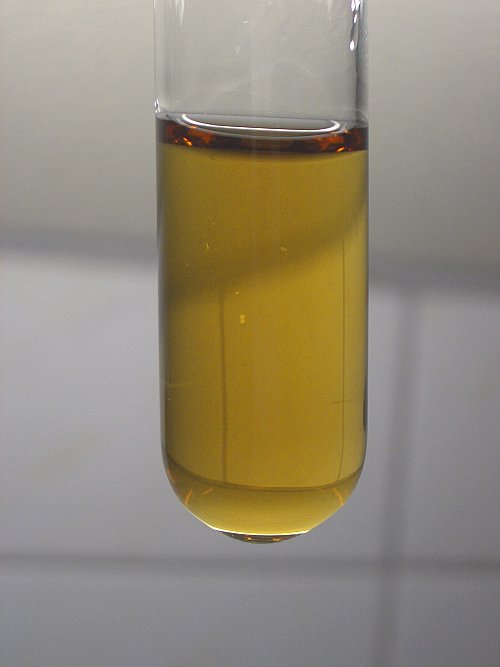
Reduction with sulfite in solution of ammonia
When some sodium sulfite is added to the still warm golden yellow solution of the previous experiment, then the color becomes pale yellow and the liquid becomes very slightly turbid. This very much resembles the outcome of the experiment where sulfite is added to the deep red acidic solution, described above, but the reaction conditions are very different. Here, there is excess ammonia, while in the previous experiment with sulfite, there is excess hydrochloric acid. The liquid, with sulfite added, becomes pale yellow/brown. On standing for one day, a dark blue precipitate is formed, which settles at the bottom. The pale yellow/brown liquid, formed immediately after adding sodium sulfite to the golden yellow liquid is shown on the left. The same liquid, one day later, with blue precipitate, is shown on the right. The blue precipitate is hydrous IrO2.
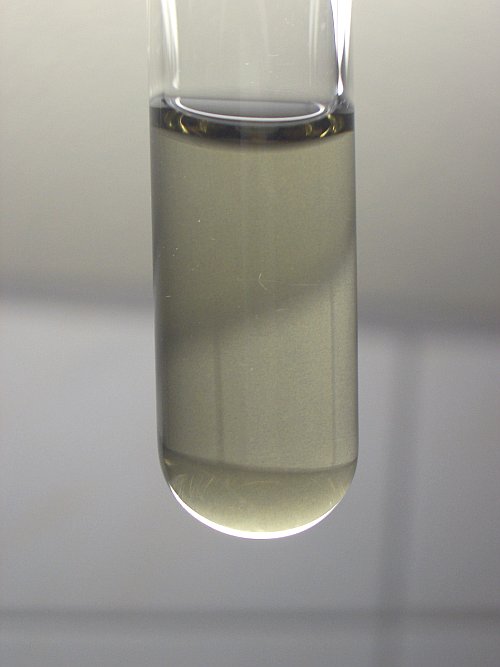
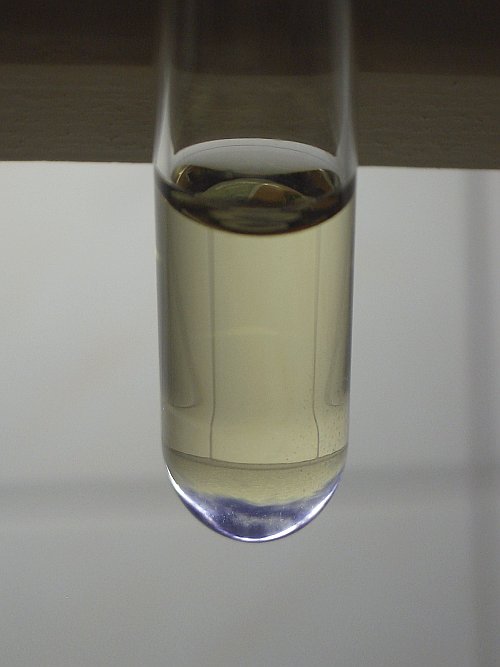
Oxidation with air, or just complex formation?
When a small amount of the dark green solution of "IrCl4" is taken, and acidified with some dilute hydrochloric acid, then it remains green. However, when it is heated for some time, then its color shifts to dark red/brown, very similar to the color of the IrCl62- complex. This could be because of oxidation by oxygen from the air, it also could be simply because of the fact that there is "IrCl4" in solution, and together with the Cl– from the hydrochloric acid, this could give rise to the red complex:
"IrCl4" + 2Cl– → IrCl62-
A picture of the resulting solution is given here:
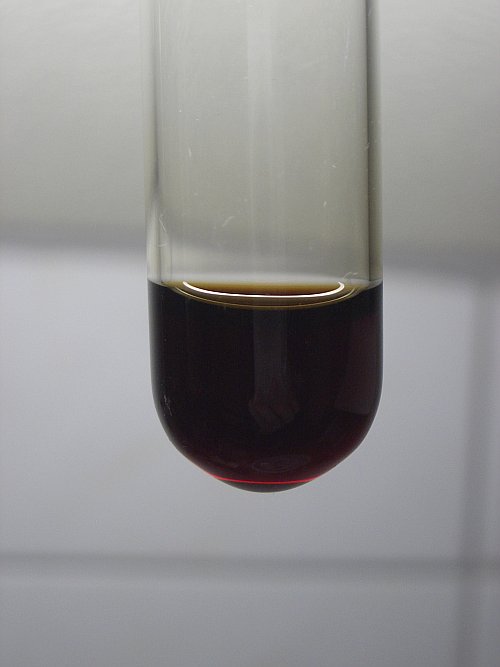
This liquid looks very much like a more concentrated version of the liquid, which is made, when the green solution is oxidized with sodium persulfate. In this experiment the starting concentration was higher than in the previous experiments. Most likely, indeed, this liquid also contains IrCl62- complex. When a few drops of the dark solution are added to dilute ammonia, a nice apple-green solution is obtained, instead of the bluish/grey/green solution, which is obtained from a non-acidified, not-heated dark green solution.
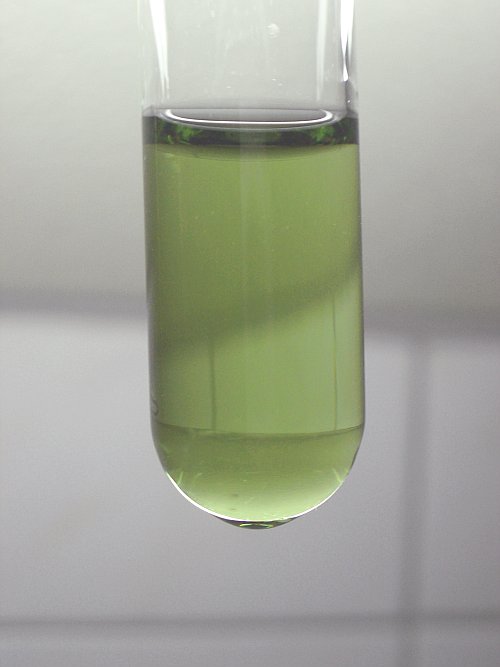
Again, oxidation with persulfate in dilute ammonia solution
When some sodium persulfate is added to this apple green solution and the liquid is gently heated (just warm, no boiling), then a whole range of colors is obtained in succession. Within a few tens of seconds, the liquid goes through all kinds of colors and it finally becomes golden yellow. The following four pictures show these colors:
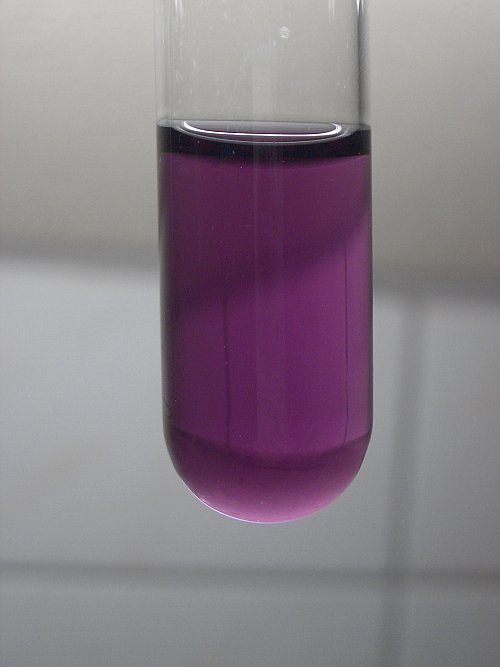
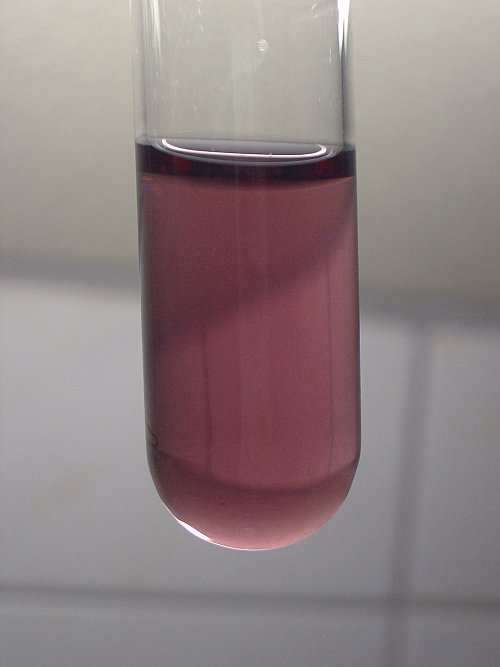
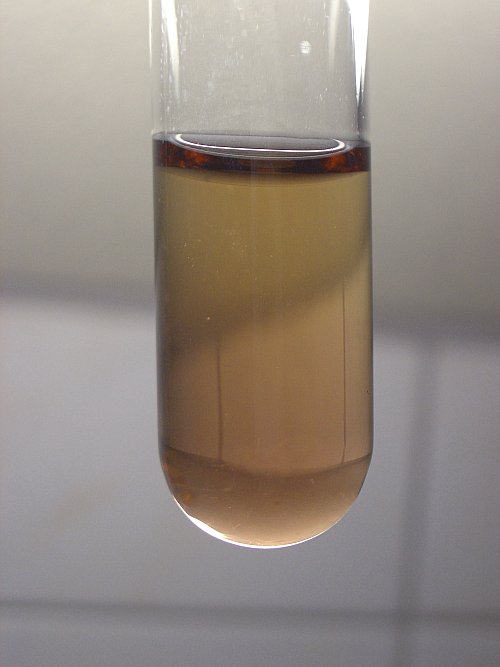
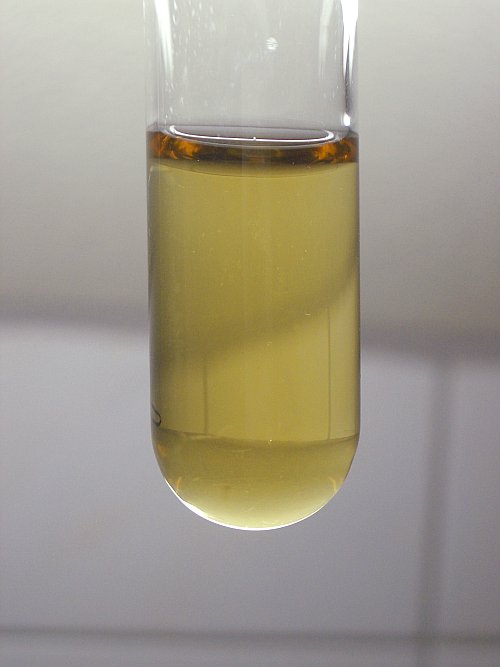
![]()
The rainbow of colors
Here, all colors are presented on a row, and one indeed can make a rainbow of colors from all the iridium compounds, prepared here.









![]()
Discussion of results
The observed colors of the iridium salts are really remarkable. The aqueous chemistry of this element is incredibly rich, but also very complex. Unfortunately, no explanation can be given for most of the observations, given here. Even the starting solution, prepared from the solid "IrCl4" is not well-specified.
According to literature, there is severe doubt about the existence of other tetrahalides of iridium besides IrF4. None of the other tetrahalides is an established compound. On the other hand, many chemical suppliers offer "IrCl4", which also is used here. This situation already is saying very much about the relatively under-developed chemistry of iridium and still a lot of research needs to be done on this subject. The only really established compound, which is well-known and well-defined is the deep red complex IrCl62-, which also could be prepared without doubt in some of the experiments described on this page.